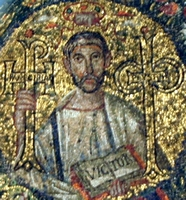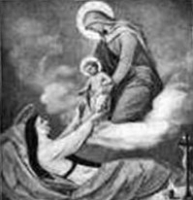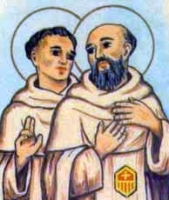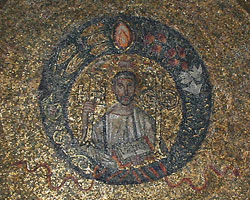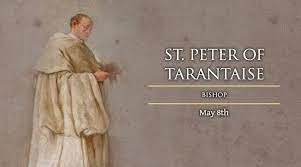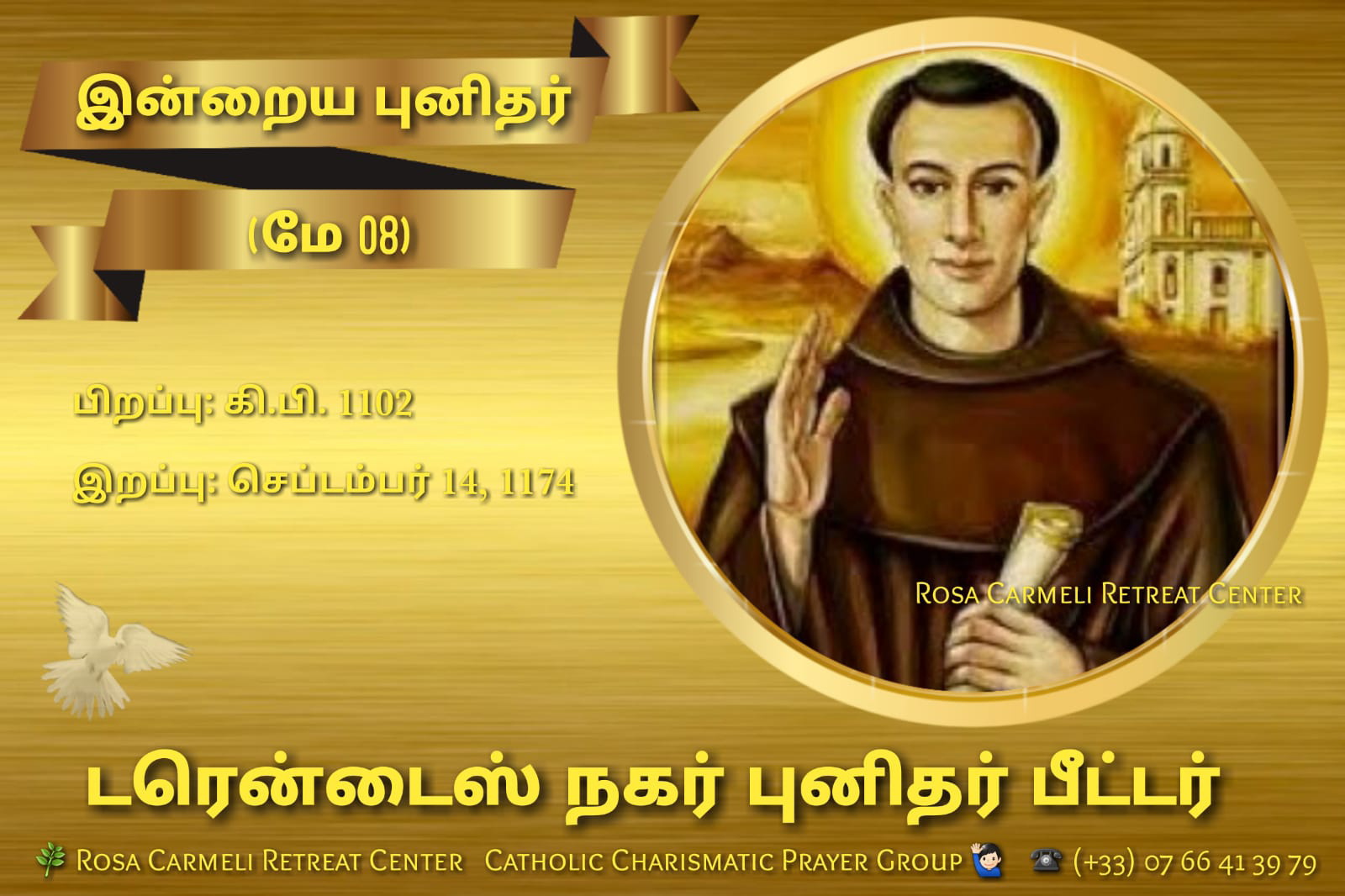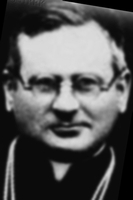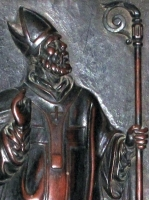Apparition of Saint Michael the Archangel
It is recorded that Saint Michael, in a vision, admonished the bishop of Siponto to build a church in his honour on Mount Gargano, now called Monte-de-Sant-Angelo, in the Capitanate, near Manfredonia, in the kingdom of Naples. This history is confirmed by Sigebert in his chronicle, and by the ancient tradition of the churches of that country, and is approved authentic by the judicious critic Mabillon, who visited those places, and examined the records and monuments. This church was erected in the fifth century, and is a place of great devotion.
When the Emperor Otho III had, contrary to his word, put to death, for rebellion, Crescentius, a Roman senator; being touched with remorse, he cast himself at the feet of Saint Romuald, who, in satisfaction for his crime, enjoined him to walk barefoot, on a penitential pilgrimage, to Saint Michael's on Mount Gargano: which penance he performed in 1002, as Saint Peter Damian relates. In France, Aubert, bishop of Avranches, moved, it is said, by certain visions, built, in 708, a church in honour of Saint Michael, on a barren rock which hangs over the sea, between Normandy and Brittany. In the tenth age, this collegiate church was changed into a great Benedictin abbey. In imitation of this was the famous church of Saint Michael refounded in Cornwall, in the reign of William the Conqueror, by William earl of Moreton, on a mountain which the tide encompasses. It is said by Borlace, the learned and accurate antiquarian of Cornwall, that this church of Saint Michael was first built in the fifth century.
The Greeks mention, in their Menaea, a famous apparition of Saint Michael at Chone, the ancient Colossae in Phrygia. Many apparitions of good angels in favour of men are recorded, both in the Old and New Testament. It is mentioned in particular of this special guardian and protector of the church, that, in the persecution of Antichrist, he will powerfully stand up in her defence: At that time shall Michael rise up, the great prince, who standeth for the children of thy people. He is not only the protector of the church, but of every faithful soul. He defeated the devil by humility; we are enlisted in the same warfare. His arms were humility and ardent love of God; the same must be our weapons. We ought to regard this archangel as our leader under God: and, courageously resisting the devil in all his assaults, to cry out: Who can be compared to God?
Blessed Ulrika Fransiska Nisch
Also known as
Fransiska Dettenrieder
Profile
Oldest of eleven children born to Ulrich Nisch, who cleaned stables, and Klothilde Dettenrieder, a servant in a village inn. The couple was so poor that their families and the local authorities refused to allow their marriage; they forced the issue with the birth of Fransiska. The baby was baptized at the age of one day. Only four Fransiska's siblings reached adulthood.
Fransiska spent her early childhood in Oberdorf, Germany, raised by her grandmother and maternal aunt, Gertrud Dettenrieder. When she was returned to her parents at age seven, she had so much trouble fitting in that she eventually returned to Oberdorf to live with her aunt and finish school. Known as a pious child, Fransiska early felt a call to religious life, but beginning in 1894 she worked as a maid in serveral homes to support her family. She made her First Communion on 21 April 1895, and was confirmed later that year. In 1898 she worked at a general store and cheese factory in Sauggart, Germany. Worked at a combination bakery, brewer and tavern in Biberach, Germany in 1899. Servant in the house of a teacher in Rorschach, Switzerland in 1901.
In 1903 she began suffering from a severe form of erysipelas in 1903; in hospital she was treated by the Sisters of Charity of Holy Cross, and was so impressed by them that she followed her call to religious vocation by joining the Sisters on 17 October 1904 at the Hegne monastery in Konstanz, Germany, taking the name Ulrika in honour of her father. She spent her few remaining years working in the kitchens of several houses in her Order amd dealing with a series of deep mystical experiences.
Born
18 September 1882 in Oberdorg-Mittelbiberach, Germany as Fransiska Dettenrieder, named for a great-grandmother
Died
8 May 1913 at the Saint Elizabeth hospital in the House of Hegne, Baden-Baden, Germany of tuberculosis
Beatified
• 1 November 1987 by Pope John Paul II
• beatification celebrated at Saint Peter's Basilica, Rome, Italy by Pope John Paul II
• the beatification miracle involved the healing of incurable liver disease of Hildis Burchard Gerhards in Cologne, Germany by the intercession of Blessed Ulrika
Blessed Clara Fey
புனித.கிளாரா ஃபாய் (St.Klara Foy) துறவி, சபை நிறுவுனர்
பிறப்பு 11 ஏப்ரல் 1815 ஆஹன்(Aachen), ஜெர்மனி
இறப்பு 8 மே 1848 சிம்பல்பெல்டு(Simpelfeld), ஹாலந்து
இவர் தனது கல்வியை முடித்தபின் துறவற சபைகளை பற்றி தெரிந்து கொள்ள பல புத்தகங்களை படித்தார். ஆஹனில் பிற ந்த இவர், தனது பங்குதந்தை பவுல் உதவியுடன், பல சமூக பணி களில் தன்னை ஈடுபடுத்தினார். சிறப்பாக இளைஞர்களிடத்தில் அதிக அன்பு காட்டினார். 1837 ஆம் ஆண்டு தனது 22 ஆம் வயதில் ஆஹனில் இளைஞர்களுக்கென்று ஓர் பள்ளியை நிறுவினார். இப்பள்ளிக்கு தேவையான உதவிகளை செய்வதற்கு, இவரின் சமூக சேவை பணிக்குழுவில் இருந்தவர்கள் முன் வந்தனர். இவ ர்கள் அனைவரும் ஒன்றாக சேர்ந்து சமூக சேவையோடு, 1844 ஆம் ஆண்டு இறைவனின் பணிகளிலும் தங்களை ஈடுபடுத்திகொ ண்டனர். இதன் விளைவாக 1848 ஆம் ஆண்டு கிளாரா ஃபாய் அவ ர்கள் "குழந்தை இயேசுவின் ஏழைகள்" என்ற சபையை நிறுவி னார். ஏராளமான ஏழை குழந்தைகளை ஒன்று சேர்த்து அவர் களை பராமரித்தார்கள் இச்சபை கன்னியர்கள். அதோடு கல்வி கற்றுக் கொடுத்து, வாழ்விற்கு வழிகாட்டி, தாய்க்குத் தாயாக இருந்து பராமரித்தார்கள். நாளடைவில் குழந்தைகளின் எண் ணிக்கை பெருகவே மீண்டும் ஓர் துறவற இல்லத்தை நிறுவி னார். இதில் பல கைவிடப்பட்ட பெண்களும், விதவைகளும் வந்து சேர்ந்தனர். கிளாரா இச்சபையை தொடங்கிய 15 ஆம் ஆண்டுகளில் ஜெர்மனி முழுவதும் 19 துறவற மடங்களை துவ ங்கினார். சில கலாச்சார வேறுபாடுகளின் அடிப்படையில் இவ ரது சபை ஹாலந்து நாட்டிலும் தொடங்கப்படவேண்டியதாக இருந்தது. இதனால் ஹாலந்து நாட்டில் ஓர் துறவற மடம் தொடங் கப்பட்டு, அந்த மடமே பிற்காலத்தில் இச்சபையின் தலைமை இல்லமாகவும் அமைந்தது. இச்சபையின் முதல் சபைத்தலைவி யாக கிளாரா ஃபாய் அவர்களே பொறுப்பேற்றார். பல ஏழை குழ ந்தைகளுக்கும், கைவிடப்பட்ட பெண்களுக்கும், விதவைகளுக் கும் தாயான இவர் இறந்தபிறகு ஹாலந்து நாட்டிலுள்ள சிம்பல் பெல்டு என்ற ஊரில் அடக்கம் செய்யப்பட்டு, இவரை முன் மாதி ரியாக கொண்டு இன்றுவரை இச்சபைத்துறவிகள் பணியா ற்றிவருகிறார்கள்
Also known as
Klara
Profile
Fourth of five children born to Louis and Katherine Fey; her father was a wealthy textile industrialist who died of a stroke in 1820 when Clara was five years old. The girl grew up well off, but became acutely concerned about the plight of the poor in her city. Her family was active in the Church; Clara's brother became a priest, and she was acquainted with Blessed Pauline von Mallinckrodt and Blessed Franziska Schervier. In 1835 she began reading the work of Saint Teresa of Ávila, and was drawn to Carmelite spirituality. In 1837 she and some like-minded friends she set up a school for poor children in Aachen, Germany. In 1841, following the recommendation of her spiritual director, she began studying the work of Saint Francis de Sales. Founded the Sisters of the Poor Child Jesus on 2 February 1844 in Aachen with a Rule based on the teaching of Saint Augustine, and with a mission to educate children in religion and in secular matters in a religious environment; Mother Clara served the rest of her life as their first superior. She received diocesan approval on 28 January 1848 and made her profession in 1850. The Sisters received a papal decree of praise on 11 July 1862 from Pope Pius IX; in 1875, during the anti–Catholic German Kulturkampf, the Sisters moved to Simpelveld, Netherlands, though there are plans to move back to Aachen in the near future; they received full papal approval from Pope Leo XIII on 15 June 1888, and continue their good work today with over 500 sisters in 12 nations of Europe, South America, and Asia.
Born
11 April 1815 in Aachen, North Rhein-Westphalia, Germany
Died
8 May 1894 in Simpelveld, Limburg, Netherlands of natural causes
Beatified
• 5 May 2018 by Pope Francis
• beatification recognition celebrated at the cathedral of Aachen, North Rhein-Westphalia, Germany
Blessed Marie-Catherine de Saint-Augustin
Also known as
• Catherine Symon of Longprey
• Marie-Catherine Simon de Longpré
• Marie-Catherine Symon de Longprey
• Mary Catherine of Saint Augustine
Profile
Raised primarily by her grandparents, Marie-Catherine was a pious girl noted for her concern for the poor and sick. She became a Augustinian canoness regular sister in the Hospitaller Sisters of the Mercy on 24 October 1644, taking the name Marie-Catherine de Saint-Augustin and serving in the Hôtel-Dieu, the hospital that the Order operated in Bayeux, France.
In 1648 she volunteered to help establish the hospital, Hôtel-Dieu de Québec, to provide medical services to the region around Quebec in New France. While travelling, Sister Marie-Catherine became severely ill; she attributed her cure to the intercession of the Blessed Virgin Mary. At the new hospital, while serving as the organization’s treasurer, she was known for caring for the physical and spiritual well-being of her patients. She learned the languages of the area First Peoples in order to better care for them. Novice mistress to the new Augustinians brought to the order by the work of the sisters. She spent her spare time in prayer and penance in support of the hospital mission. For her endless work and devotion, Mother Catherine is honoured as one of the six founders of the Catholic Church in Canada.
Born
3 May 1632 in Saint-Sauveur-le-Vicomte, Normandy, France
Died
• 8 May 1668 in the Hôtel-Dieu de Québec, Québec City, New France (modern Canada) of natural causes
• relics enshrined at the Centre Catherine-de-Saint-Augustin next to the Hôtel-Dieu de Québec
Beatified
23 April 1989 by Pope John Paul II
Blessed Teresa Demjanovich
Also known as
Sister Miriam Teresa
Profile
One of five children born to Alexander and Johanna Demjanovich, emmigrants to the United States from an area of the Austro-Hungarian empire that is in modern Slovakia. Raised in the Byzantine-Ruthenian rite. Valedictorian of her high school class. Teacher at the Saint Aloysius Academy in Jersey City, New Jersey, and then in the city's public high school. Entered the Congregation of the Sisters of Charity of Saint Elizabeth in 1925 and died there two years later. In 1928, Sister Miriam's spiritual conferences, Greater Perfection and paved the way for her Cause as they showed the pilgrimage to God of a woman living in modern America.
Born
26 March 1901 in Bayonne, New Jersey
Died
8 May 1927 in Convent Station, New Jersey of complications follwing appendicitis
Beatified
• 4 October 2014 by Pope Francis
• beatification celebrated at the Cathedral Basilica of the Sacred Heart, Newark, New Jersey, presided by Cardinal Angelo Amato
Blessed Henri Vergès
Also known as
Enric Vergés
Profile
Educated from age 12 by the Marist Brothers of the Schools, he studied in Espirá de l'Aglí and Saint-Paul-Trois-Châteaux in France. Enric joined the Marists himself in 1945, and made his perpetual vows on 26 August 1952. Elementary school teacher in Nimes, France in 1947. The combination of work, study and Marist frugality led to health problems, and in 1950 Henri had to spend time in hospital in Osséja, France. Teacher in Le Cheylard, France in 1952. Novice instructor in Aubenas and Bordeaux in France. Sub-master of the novices at Notre-Dame de Lacabane, Corrèze, France from 1958 to 1966. Marist superior in Bourg-de-Péage and Ganges in France. Delegate to the Marist general chapter in 1967. Received a degree in philosophy in Montpellier, France in 1968. After studying Arabic, he was appointed director of the Saint-Bonaventure school in Algiers from 1969 till 1976 when the school was nationalized by the Algerian government. Professor of mathematics at the school of Sour-El-Ghozlane from 1976 to 1988. Director of the library of the Archdiocese of Algiers on Ben Cheneb Street in the casbah from 1988 until his death. Murdered by Muslim fundamentalists. Martyr.
Born
15 July 1930 in Matemale, Pyrénées-Orientales, France
Died
• shot twice in the head on 8 May 1994 in the Archdiocese library in Algiers, Algeria
• buried in Algiers on 12 May 1994
Beatified
8 December 2018 by Pope Francis
Pope Saint Boniface IV
Profile
Son of a physician named John. Student under Saint Gregory the Great. Benedictine monk at the Saint Sebastian Abbey in Rome, Italy. Served as deacon under Saint Gregory the Great; dispenser of alms and patrimonies. Chosen 67th Pope in 608.
Converted the Roman temple of the old gods, the Pantheon, to a Christian church dedicated to Our Lady and all the Martyrs in 609, the first such conversion of a temple from pagan to Christian use in Rome. Supported the expansion of the faith into England, and met with the first bishop of London. Encouraged reforms among the clergy, and balanced it with improvements in their living and working conditions. Corresponded with Saint Columba. Worked to alleviate the sufferings in Rome due to famine and the disease that follows it. Late in life he converted his own house into a monastery and lived there, dividing his time between his papal work and life as a prayerful monk.
Born
c.550 at Valeria, Abruzzi, Italy
Papal Ascension
25 August 608
Died
• 615 at Rome, Italy of natural causes
• relics moved c.1100
• relics moved in the late 13th century by order of Pope Boniface VIII
• relics re-interred in Saint Peter's Basilica, Rome, Italy on 21 October 1603
Blessed Paul-Hélène Saint Raymond
Also known as
Madame Encyclopédie
Profile
Eighth of ten children born into a pious family. Paul-Hélène studied engineering at the Sorbonne in Paris, France, but felt a call to religious life, and joined the Little Sisters of the Assumption in 1952, making her final vows in 1960. Family social worker in Creil, France from 1954 until 1957 when she began studying to be a nurse. She worked as a nurse in poor, working class neigbbourhoods in Rouen, France. Assigned to work as a nurse and social worker in Algeria in 1964 where she served for 30 years. She is remembered as intelligent, educated, helpful, generous, prayerful, and honest to the point of sometimes being blunt and tactless. Retiring from medical and social work, she assisted Blessed Henri Vergès at the archdiocese library where she was known for welcoming children and teenagers. Murdered by Muslim fundamentalists who entered the library disguised as police officers. Martyr.
Born
24 January 1927 in Paris, France
Died
• shot in the neck on 8 May 1994 in the Archdiocese library on Ben Cheneb Street in the Kasbah in Algiers, Algeria
• funeral Mass celebrated at the Basilica of Our Lady of Africa
Beatified
8 December 2018 by Pope Francis
Our Lady of Luján
Profile
The Virgin is a two feet tall terracotta statue of Our Lady. It was made in Brazil and sent to Argentina in May 1630. Its original appearance seemed inspired by Murillo's Immaculates. In 1887, to preserve and protect it, the image was given a solid silver covering. It is usually clothed with a white robe and sky blue cloak, the colors of the Argentinian flag. Only the dark oval face with big blue eyes and the hands folded in prayer are now visible.
Tradition says that an ox-drawn wagon was taking the statue from Buenos Aires to Santiago del Estero. The animals stopped at the Luján River and refused to cross. Through trial and error the teamsters discovered that it the box with the Virgin was in the wagon, the oxen would not move; if it was removed, then away they went. After testing this several times, the people realized that Our Lady wanted to stay in Luján, and so she is there today.
The image was first taken to the nearby home of Don Rosendo. He built a primitive chapel for it which lasted 40 years. A bigger shrine was completed in 1685. A new sanctuary was built in the 19th century. The image was crowned canonically in 1887. In 1930 Pope Pius XII gave the sanctuary the title of Basilica.
Patronage
• Agentina (proclaimed on 8 September 1930 Pope Pius XI)
• Argentinian military chaplains
• Paraguay
• Uruguay
Saint Acacius of Byzantium
Also known as
• Acacius of Constantinople
• Acato of Avila
• Acathius
• Achatius of Byzantium
• Agathius of Byzantium
• Agathus of Byzantium
• Agazio (in Calabria)
• Cuenca (in Spain)
Additional Memorial
• 16 January (translation of relics)
• 17 April (Orthodox calendar)
Profile
Christian centurian in the imperial Roman army stationed in Thrace. Tortured and executed in the persecutions of Diocletian. Several churches in Constantinople dedicated to him, including one dedicated by Constantine the Great. One of the Fourteen Holy Helpers.
Born
Cappadocian
Died
tortured, scourged, and beheaded c.303 in Constantinople
Patronage
• against headaches
• soldiers
Saint Victor Maurus
Also known as
• Victor the Moor
• Viktor; Vittore; Vittorio
Profile
Soldier in the Roman Praetorian Guard. A Christian from his youth, Victor lived in quiet praise of God. Around 303, the elderly Victor was arrested in Milan, Italy in the persecutions of Maximian. He was tortured for his faith, basted in molten lead, and killed. Martyr. Saint Gregory of Tours wrote of miracles that occurred at Victor's grave.
Born
3rd century in Mauretania, Africa
Died
• beheaded c.303
• buried outside Milan, Italy
• a church was later erected over the grave
• relics translated in 1576 to an Olivetan church dedicated to him in Milan
Patronage
• Asigliano, Italy
• Balangero, Italy
• Borghetto, Italy
• Canale, Italy
• Caselle Torinese, Italy
• Feletto, Italy
• Odolengo, Italy
• Quagliuzzo, Italy
• Rho, Italy
• San Vittore Olona, Italy
• Varese, Italy
• Verbania, Italy
Saint Amatus Ronconi
Also known as
Amato
Profile
Born to a wealthy family, Amatus was orphaned when very young and grew up in the home of his older brother Giacomo. Feeling a call to live according to the gospel, he devoted himself to caring for the poor and helping pilgrims. Franciscan tertiary. Constructed combination chapel and shelters for pilgrims including the Beato Amato Ronconi Nursing Home which still exists. Made four pilgrimages to Santiago de Compostela in Spain. Benedictine lay brother.
Born
c.1225 in Saludécio, Rimini, Italy
Died
• 8 May 1292 in Saludécio, Rimini, Italy of natural causes
• interred in the chapel shelters he had built
• relics transferred to the Pieve di San Biagio in May 1330 after the chapel shelters were destroyed by fire
Beatified
• 17 April 1776 by Pope Pius VI (cultus confirmation)
• 9 October 2013 by Pope Francis (decree of heroic virtues)
Canonized
23 November 2014 by Pope Francis
Patronage
Saludécio, Italy
Blessed Aloysius Luis Rabata
Profile
Carmelite priest. Prior of the reformed convent in Randazzo, Italy.
Born
c.1430 at Erice, Sicily
Died
• murdered in 1490 in Trapani, Italy by a head wound
• before he died he forgave his attacker, and refused to say who it was for fear the person would be punished
• buried under the main altar at the church at the Carmelite convent in Trapani
• some relics transferred to Sicily in 1617
• relics transferred to an urn under the altar of the Assumption in the basilica of Santa Maria on 13 August 1913
Beatified
10 December 1841 by Pope Gregory XVI (cultus confirmed)
Blessed Angelo of Massaccio
Also known as
• Angelo of Cupramontana
• Angel...
Profile
Camaldolese monk at the Santa Maria della Serra monastery near Cupramontana, Italy. Prior of his house. Priest. Martyr by Berlotani heretic wood cutters when he chastised them for ignoring the Sabbath.
Born
late 14 century in Massaccio (modern Cupramontana), Italy
Died
• hit with an axe c.1458 near the monastery of Santa Maria della Serra near Cupramontana, Italy
• by 1492 he was interred under the altar in the church at Santa Maria della Serra, now known as the church of Sant Angelo
Beatified
27 September 1842 by Pope Gregory XVI (cultus confirmation)
Patronage
Cupramontana, Italy
Saint Ida of Nivelles
Also known as
• Ida of Metz
• Iduberga; Ita; Itta; Itte
Profile
Daughter of Bishop Arnoald of Metz. Sister of Saint Modoald of Trier and Saint Severa. Married to Saint Pepin of Landen. Mother of Saint Gertrude of Nivelles, Saint Begga of Ardenne, and Grimoald, mayor of the palace. Grandmother of Pepin of Herstal. Friend of Saint Amand of Maastricht. Widowed, she built a Benedictine double monastery at Nivelles, Belgium under the leadership of her daughter, Saint Gertrude; Ida spent the rest of her life there as a nun.
Born
592
Died
8 May 652 in Nivelles, Belgium of natural causes
Patronage
• against erysipelas; erysipelas patients
• against toothache; toothache sufferers
Pope Saint Benedict II
Profile
Son of John. Studied at the schola cantorum, and was early known as a Bible scholar; noted singer, too. Priest, known for his care for the poor. Pope; the delay in his ascension was caused by waiting for imperial confirmation.
Obtained the decree that abolished imperial confirmation of popes. Adopted Constantine's two sons. Fought Monothelitism, and worked with Spanish bishops to restore orthodoxy in their dioceses. Restored many churches in Rome, and endowed deaconries to care for the poor.
Born
at Rome, Italy
Papal Ascension
• elected in 683
• ascended on 26 June 684
Died
• 8 May 685
• buried at Saint Peter's Basilica, Rome, Italy
Saint Desideratus of Bourges
Also known as
Desire, Dezydery, Desiderato
Profile
His was a pious family; his parents turned their home into a hospital, and his brothers, Deodato and Didier, died as a martyrs. Desideratus was a courtier and advisor to king Clotaire. Fought simony and heresy. He wished to retire to life as a monk, but was chosen to serve as bishop of Bourges, France in 541. Attended the 5th Council of Orleans in 549, and the 2nd Council of Auvergne. Fought against Nestorianism.
Born
Soissons, France
Died
• 8 May 550 of natural causes
• buried in the basilica of Sant'Ursino, Bourges, France, the building of which he began
Saint Metrone of Verona
Also known as
Metro, Metron, Metronius
Profile
8th-century penitent who chained himself to a stone in front of the cathedral of Verona, Italy, threw the key into Adige River, and lived there on the street for seven years in penance. The key to his chains was found in the belly of a fish by two fishermen who took the key to the local bishop. The bishop took the return to the key as a sign, freed Metrone from his chains, and welcomed him to active Communion in the Church.
Died
• miracles reported at his grave
• relics enshrined in Verona, Italy
Saint Otger of Utrecht
Also known as
Odger; Odgero; Oteger
Profile
Worked with Saint Wiro of Utrecht to found a monastery at Odilienburg, Netherlands.
Born
England
Died
• c.746 of natural causes
• relics in Odilienberg, France
• relics taken to Roermond, Netherlands in 1361
• relics disappeared during the time of the Protestant Reformation
• relics re-discovered in 1594
• relics re-enshrined in 1881
Saint Wiro of Utrecht
Also known as
Wirone
Profile
Bishop of Utrecht, Netherlands. One of the Apostles of Frisia. He and his two companions founded a monastery at Odiliënberg, Netherlands.
Born
British Isles (location varies from source to source)
Died
• c.753 of natural causes
• buried in Roermond, Netherlands
• tomb re-discovered in August 1881
Blessed Raymond of Toulouse
Profile
Son of the Count de Montfort. Cousin of Blessed George of Lauria. While on pilgrimage to the Marian shrine of Montserrat, Raymond decided to join the Mercedarians, and took the habit at the convent of Santa Eulalia in Barcelona, Spain. Zealous preacher. Created cardinal-priest in 1335 by Pope Benedict XII.
Saint Gibrian
Also known as
Abran, Gybrian, Gobrian, Gibriano
Profile
Brother of Saint Tressan, Saint Helan, Saint Germanus, Saint Abran, Saint Petran, Saint Franca, Saint Promptia, and Saint Possenna. Hermit in Brittany in northern France. Priest. Worked with Saint Remigius.
Born
Ireland
Died
c.515
Blessed Domenico di San Pietro
Profile
Mercedarian. Helped ransom 187 Christians held in slavery by North African Moors.
Blessed Pietro de Alos
Profile
Mercedarian. Helped ransom 187 Christians held in slavery by North African Moors.
Saint Helladius of Auxerre
Profile
Bishop of Auxerre, France for 30 years. Converted Saint Amator, his successor as bishop, to the faith.
Died
387 of natural causes
Saint Arsenio of Scetis
Profile
Deacon. Hermit at Mount Scetis, Egypt.
Born
4th century
Died
5th century
Saint Martin of Saujon
Profile
Sixth century priest, monk and abbot in Saujon, Saintes, France.
Saint Peter of Besançon
Profile
Bishop of Besançon, France.
St. Victor the Moor
Feastday: May 8
Patron: of Varese, Italy
Death: 303
Martyr executed at Nicomedia, with a group, including Zoticus,Antoninus, Theonas, Chrysophorus, Severian, Acyndius, Zeno, and Caesareus. They were mentioned in the apocryphal Acts of St. George.
Victor the Moor (in Latin: Victor Maurus) (born 3rd century in Mauretania; died ca. 303 in Milan) was a native of Mauretania and a Christian martyr, according to tradition, and is venerated as a saint. Victor, born into a Christian family, was a soldier in the Roman Praetorian Guard. After he had destroyed some pagan altars, he was arrested, tortured, and killed around 303.
Veneration
Statue of St Victor in Museo del Duomo, Milan. Unknown Milanese sculptor, last decade of 15th century
Gregory of Tours claimed miracles occurred above his grave; a church was built above the supposed site. His cause was promoted by Saint Ambrose, fourth-century bishop of Milan and numerous churches have been dedicated to him in the city itself and throughout the Diocese of Milan and its neighbours.
His memorial day is May 8 in the Roman Catholic Church and the Evangelical Lutheran Church in America.
St. Odrian
Feastday: May 8
Death: 5th century
One of the first bishops of Waterford, Ireland. Waterford was part of an ancient deanery system at the time, ruled by abbot bishops. Odrian was a prelate.
Bl. Miriam Teresa Demjanovich
Feastday: May 8
Patron:
Birth: 1901
Death: 1927
Beatified: Pope Francis on October 4, 2014, in Newark, New Jersey
Miriam Teresa Demjanovich was born March 26, 1901 in Bayonne, New Jersey. She was the youngest of seven children and received her baptism, confirmation and her first Holy Communion in the Byzantine Ruthenian rite of her immigrant parents.
By the time she graduated from Bayonne High School in January 1917, she felt a calling to become a Carmelite, but remained home to care for her ailing mother.
When her mother died the following November, her family encouraged Miriam to attend the College of Saint Elizabeth at Convent Station, New Jersey. She decided to attend and graduated with the highest honors in 1923 with a literature degree.
Miriam continued to long for a religious life, but was unsure of which community to enter. While she decided, she accepting a teaching position at the Academy of Saint Aloysius in Jersey City. Several noted her humility and genuine piety, as she was often discovered kneeling in the college chapel. Her devotion to praying the rosary was also observed by many.
In her first year teaching, Miriam joined the Saint Vincent de Paul Parish choir, the Blessed Virgin Sodality, and was a member of a parish community associated with the National Catholic Welfare Conference.
All summer and fall of 1924, Miriam prayed for discernment and asked God for direction. She attempted to join the Discalced Carmelite nuns in the Bronx, New York, but was told to wait a few years due to various health issues she suffered.
During that year's Feast of the Immaculate Conception, she made a novena. On December 8, she believed she was being called to enter the Sisters of Charity of St. Elizabeth and planned to enter the convent February 2, 1925.
Unfortunately, Miriam's father passed away after catching a cold. Even if he had been well, Miriam's entrance was delayed nearly two weeks - February 11, 1925, the Feast of Our Lady of Lourdes.
When Miriam was ready to enter the convent, her brother, Charles Demjanovich, who was a priest, and two of her sisters accompanied her.
She was admitted to the novitiate of the religious congregation and received the religious habit on May 17, 1925.
As she never received an official transfer of rite, she remained a Byzantine Rite Catholic during her time as a Religious Sister in a Roman Rite congregation.
The following year, her spiritual leader, Father Benedict Bradley, asked her to write the conferences for the novitiate. She wrote twenty-six conferences, which were published following her death in a collection called Greater Perfection.
In 1926, Miriam became very ill and was forced to undergo a tonsillectomy. She was severely weak and required help to return to the convent. A few days later, she volunteered to help in the infirmary, but was told to "pull [herself] together."
Father Bradley worried over her health and called her brother, who then called his sister who was a nurse.
Miriam's sister took one look at Miriam and took her straight to a hospital, where she was diagnosed with "physical and nervous exhaustion, with myocarditis and acute appendicitis."
Miriam was quite weak and the doctors feared she would not survive an operation so they waited.
Unfortunately, her condition worsened.
It was not until May 6, 1927 than Miriam had an operation for the appendicitis. Unfortunately, she passed away two days later on May 8.
Miriam's funeral was held May 11, 1927 at Holy Family Chapel in Convent Station, New Jersey and she was buried at Holy Family Cemetery on the motherhouse of the Sisters of Charity of St. Elizabeth grounds.
Years later, Miriam was beatified by Pope Francis on October 4, 2014. Her beatification was celebrated at the Cathedral Basilica of the Sacred Heart, Newark, New Jersey and was presided by Cardinal Angelo Amato.
Miracles attributed to Miriam include the healing of a blind boy's eyes in 1963. The Vatican approved of his restored sight as a miracle accomplished through the intercession of Miriam in 2013.
Miriam Teresa Demjanovich (March 26, 1901 – May 8, 1927) was an American Ruthenian Catholic Sister of Charity who has been beatified by the Catholic Church. The beatification ceremony was the first to take place in the United States.
St. Maria Magdalen of Canossa
Feastday: May 8
Birth: 1774
Death: 1835
Canonized: Pope John Paul II
Foundress of the Daughters of Charity at Verona, Italy. Born in 1774, she was the daughter of the Marquis of Canossa, who died when Maria Magdalen was three. Her mother abandoned the family, and Maria Magdalen managed her father's estate until she was thirty-three, then founding her institute. When she died, her Daughters of Charity were widespread. She was canonized in 1988 by Pope John Paul II.
St. Indract
Feastday: May 8
Death: 710
Irish chieftain and martyr, also called Indractus. He was possibly murdered with his sister, St. Dominica, while returning home from a pilgrimage from Rome. Another tradition states that they were slain by Saxons near Glastonbury where their relics were thereafter preserved.
Indract or Indracht was an Irish saint who, along with his companions, was venerated at Glastonbury Abbey, a monastery in the county of Somerset in south-western England. In the High Middle Ages Glastonbury tradition held that he had been an Irish pilgrim — a king's son – on his way back from Rome who was molested and killed by a local thegn after he had stopped off to visit the shrine of St Patrick. This tradition synchronised his life with that of King Ine (688–726), though historian Michael Lapidge has argued that he is most likely to represent a 9th-century abbot of Iona named Indrechtach ua Fínnachta.
The cult seems to date from the late 10th or early 11th century, though this is uncertain. There is one main extant account, the anonymous 12th century Passio sancti Indracti. An earlier text written in Old English is said to have existed and been used by the writer of the Passio. There is also evidence that the 12th-century historian William of Malmesbury wrote his own saint's life, and although now lost it may also have used the Old English text. In the 14th century a St Alban's monk added significant new material of probable Cornish origin, mentioning a sister named Dominica and some miracles.
St. Dionysius
Feastday: May 8
Death: 193
Bishop of Vienne, in Dauphine, France, successor of St. Justus. He was one of the ten missionaries sent with St. Peregrinus to Gaul, by Pope St. Sixtus I.
St. Abran
Feastday: May 8
Death: 515
Hermit also called Gibrian. From Ireland, Abran, the eldest of five brothers and three sisters, sailed to Brittany with his siblings. There all of them continued their hermitages and greatly influenced the people of the area. Abran and his brothers and sisters were all declared saints.
Saint Abran (Breton for 'Abraham'), also known as Gibrian, was a 6th-century Irish hermit in Brittany.
He was born in Ireland and with eight of his siblings travelled to Brittany. St. Abran and his siblings chose a life of devotion to the God in the consecrated religious life. He lived in a hermitage on the Marne River, which had been given to him by Saint Remigius.
Abran and his siblings are all considered saints for their positive Christian influence upon the Breton people.
Saint Abran's feast day is 8 May on the Western Rite Orthodox and Roman Catholic Church calendars.
டரென்டைஸ் நகர் புனிதர் பீட்டர்
(St. Peter of Tarentaise)
டரென்டைஸ் பேராயர்:
(Archbishop of Tarentaise)
பிறப்பு: கி.பி. 1102
புனித மௌரிஸ்-இ'எக்ஸில், ஃபிரான்ஸ்
(Saint-Maurice-l'Exil, France)
இறப்பு: செப்டம்பர் 14, 1174 (வயது 72)
பெல்லேவாக்ஸ் துறவுமடம், ஃபிரான்ஸ்
(Bellevaux Abbey, France)
ஏற்கும் சமயம்:
ரோமன் கத்தோலிக்க திருச்சபை
(Roman Catholic Church)
புனிதர் பட்டம்: மே 10, 1191
திருத்தந்தை மூன்றாம் செலேஸ்டின்
(Pope Celestine III)
நினைவுத் திருநாள்: மே 8
பாதுகாவல்:
டரென்டைஸ் (Tarentaise)
புனிதர் பீட்டர் (Saint Peter of Tarentaise) ஒரு ஃபிரெஞ்ச் ரோமன் கத்தோலிக்க துறவு மடாதிபதியும் (French Roman Catholic abbot), கி.பி. 1141ம் ஆண்டு முதல், தமது மரணம் வரை “டரென்டைஸ்” (Tarentaise) உயர்மறைமாவட்ட பேராயராக பணியாற்றியவருமாவார்.
அவரது குழந்தை பருவத்திலும், இளமை பருவத்திலும் அவர் பிறருக்கு முன்மாதிரியாக வாழ்ந்தார். அவரது பெற்றோர் மற்றும் உடன்பிறந்தவர்கள் அனைவருமே மத வாழ்க்கையில் அவரைப் பின்பற்றினர். அவர் ஒரு புதிய துறவு மடத்தின் மடாதிபதியாக பணியாற்றினார். புனிதர் பெர்னார்ட் (Saint Bernard of Clairvaux) உள்ளிட்ட உயர் பொருப்பிலிருந்தவர்கள் இவரை உயர் பதவிகளை ஏற்குமாறு வற்புறுத்தினர். ஆனால் இவர் அவற்றையெல்லாம் மறுத்தார். ஆனால் அவரது இதயம், அவரது எளிய மற்றும் பக்தியான வாழ்க்கைக்காக, ஒரு துறவி என்ற இழப்புக்காக துபுற்றது. அவர் ஒருமுறை கான்வென்ட் வரை ஓடி வந்து, மறைந்து வாழ முயற்சித்தார். அவர் ஊழல் மற்றும் ஒழுக்கங்கெட்ட குருக்கள் அனைவரையும் அகற்றினார். ஏழைகளுக்கும், வீடற்றவர்களுக்கும் உதவும் நல்லெண்ணத்தில், அவர் கடுமையான வானிலைகளின்போது, தனது சொந்த வாழ்க்கையை ஆபத்திற்குள்ளாக்கி இருந்துள்ளார்.
பியர்ரே (Pierre) எனும் இயற்பெயர் கொண்ட பீட்டர், கி.பி. 1102ம் ஆண்டு, ஃபிரான்ஸ் நாட்டின் "ரோன்-ஆல்ப்ஸ்" மலைகளின் (Rhône-Alpes mountains) நகர்ப் பகுதியொன்றில் பிறந்தார். "சிஸ்டர்சியன் துறவியர் சபையில்" (Cistercian monastic order) இணைந்த இவர், கி.பி. 1132ம் ஆண்டு, "டமீ" (Tamié) என்னுமிடத்திலுள்ள துறவு மடத்தின் மடாதிபதியானார்.
1142ம் ஆண்டு, "டரென்டைஸ்" உயர் மறை மாவட்டத்தின் (Archbishop of Tarentaise) பேராயர் பதவியை தயக்கத்துடன் ஏற்றுக்கொண்டார். ஒரு துறவு மடாதிபதியாக தாம் கற்றுக்கொண்ட "சிஸ்டர்சியன் கொள்கைகளை" (Cistercian principles) சிதைந்து கொண்டிருந்த தமது மறை மாவட்டத்தில் நடைமுறைப்படுத்தினார். அதில் வெற்றியும் கண்டார்.
இவர் ஸ்விட்சர்லாந்து (Switzerland) மற்றும் இத்தாலி (Italy) நாடுகளினிடையே பயணம் செய்பவர்களின் நலன்களிலும் அக்கறை காட்டினார். பொதுவாகவே, பீட்டர் தமது ஆயர் பதவியினால் மகிழ்ச்சியுடன் காணப்படவில்லை. அவர் அடிக்கடி காணாமலும் போனார். இடையில் ஒரு வருடம் (1155) அவர் காணாமல் போய் ஸ்விட்சர்லாந்தின் ஒரு தொலைதூர துறவியர் மடத்தில் காணப்பட்டார் என்பர்.
ஃபிரான்ஸ் நாட்டின் அரசன் ஏழாம் லூயிஸ் (King Louis VII of France) மற்றும் இங்கிலாந்தின் அரசன் இரண்டாம் ஹென்றி (King Henry II of England) ஆகியோரிடையே நடந்த பேச்சுவார்த்தைகளில் திருத்தந்தை மூன்றாம் அலெக்சாண்டரின் (Pope Alexander III) சார்பில் பீட்டர் கலந்துகொண்டார். ஒருமுறை அதேபோன்றதொரு பேச்சுவார்த்தையில் கலந்துகொண்டு திரும்புகையில், ஃபிரான்ஸின் "பெல்லேவாக்ஸ்" (Monastery at Bellevaux) துறவு மடத்தில் மரித்தார்.
Archbishop of Tarentaise:
Born: 1102 AD
Saint-Maurice-l 'Exil, Kingdom of France
Died: September 14, 1174 (Aged 72)
Bellevaux Abbey, Cirey, Franche-Comté, Kingdom of France
Venerated in: Roman Catholic Church
Canonized: May 10, 1191
Pope Celestine III
Feast Day: May 08
Patronage: Tarentaise
Saint Pierre de Tarentaise was a French Roman Catholic Cistercian who served as the Archbishop of Tarentaise from 1141 until his death.
St. Peter of Tarentaise was born in 1102 near Vienne, France. When he was 20, he entered the Cistercian Order, convincing his family to join him. Two brothers and his father entered the religious community of Bonnevaux with him, and his sister became religious.
Ten years after his entry, Peter was sent to found a new house in Switzerland, in the Tarentaise mountains. He also opened a hospital, which served as a guest house for travellers through the mountains.
In 1442, Peter was appointed as Archbishop of Tarentaise. Although he was the happiest living the simple life of a monk, he accepted at the urging of St. Bernard and other monks in his order. As bishop, Peter reformed the diocese and began programs to provide education and food to the poor. His tradition of donating food, called “My Bread,” lasted until the French Revolution in 1789.
Peter performed many miraculous healings as a bishop, but after 13 years, he fled his diocese disguised as a lay brother and went to a Cistercian abbey in Switzerland. He hid there for about a year until he was discovered and his superiors forced him to return to Tarentaise.
When the anti-pope Victor and the true Pope Alexander III were at strife, Peter was one of the only major Church voices to support Alexander’s claim, even going against the emperor Frederick Barbarossa. Pope Alexander III recognized Peter’s loyalty and holiness and sent him to reconcile King Louis VII of France and Henry II of England. Shortly after an unsuccessful reconciliation attempt, St. Peter died of an illness in 1175. He was canonized in 1191.
St. Peter of Tarentaise, you tried to run away from your duties as a bishop, but became known as a man of great peace—pray for us!











